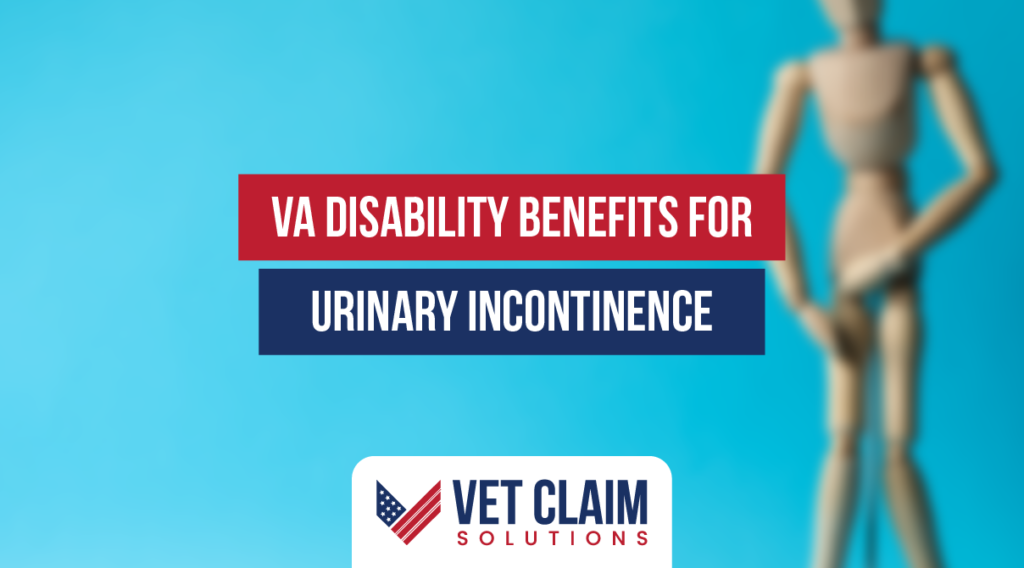VA Disability Urinary incontinence can be a debilitating condition that not only affects a person’s physical health but also their emotional well-being. For veterans who are suffering from urinary incontinence as a result of their military service, there is some relief available in the form of VA disability benefits. These benefits aim to provide financial assistance and medical care to veterans who are unable to work or experience discomfort due to their urinary incontinence. In this article, we will explore the eligibility criteria for VA disability benefits for urinary incontinence and How VA Rates Urinary Incontinence
What is Urinary Incontinence?

Urinary incontinence is a medical condition characterized by the involuntary loss of urine from the bladder, leading to unintentional leakage. It occurs when the normal control mechanisms of the urinary system are disrupted, causing a person to have limited or no control over when and where they urinate. Urinary incontinence can be a distressing and embarrassing condition, affecting people of all ages, but it is more prevalent among Veterans.
Types of Urinary Incontinence
There are several types of urinary incontinence, each with its own underlying causes:

Stress incontinence:
This occurs when physical activities such as coughing, sneezing, laughing, lifting heavy objects, or even simple movements put pressure on the bladder and cause urine to leak. It is commonly associated with weakened pelvic floor muscles, often as a result of childbirth, aging, or certain medical conditions.

Urge incontinence:
Also known as “overactive bladder,” this type of incontinence is characterized by a sudden and intense urge to urinate, followed by involuntary leakage before reaching the toilet. It results from an overactive detrusor muscle (the muscle that contracts to empty the bladder), causing the bladder to contract unexpectedly.

Overflow incontinence:
This occurs when the bladder does not empty completely during urination, leading to a constant dribbling or frequent leakage. It is often caused by an obstruction or nerve damage that interferes with the normal emptying of the bladder.

Functional incontinence:
In this type of incontinence, the person may have normal urinary control, but they face difficulties in reaching the toilet in time due to physical or cognitive impairments, such as severe arthritis or dementia.

Mixed incontinence:
Some individuals may experience a combination of two or more types of incontinence, such as a mixture of stress and urge incontinence.
Causes of Urinary Incontinence in Veterans
There are several contributing factors to the development of urinary incontinence in veterans. One primary cause is the weakening of pelvic muscles, which can result from various medical conditions, ranging from temporary problems like urinary tract infections (UTIs) to more permanent and severe conditions like prostate cancer or neurological disorders.
During active duty, veterans often face challenging and demanding conditions, including limited access to restroom facilities and proper hygiene resources. This lack of access can be particularly problematic for female veterans, leading to an increased risk of UTIs, which, in turn, can trigger urinary incontinence.

Moreover, post-traumatic stress disorder (PTSD) can play a significant role in urinary incontinence, especially among female veterans. The psychological and emotional toll of combat and traumatic experiences can manifest physically, and incontinence may be one of the potential physical manifestations.
Additionally, traumatic brain injury (TBI) is a serious concern for many veterans, and it can contribute to urinary incontinence. Damage to the brain resulting from a traumatic injury can disrupt nerve signals and control mechanisms that regulate bladder function, leading to involuntary leakage.
While the aforementioned factors are some of the more common reasons for urinary incontinence in veterans, it is crucial to recognize that each individual’s situation may vary. Some veterans may experience a combination of these factors, while others may face unique circumstances leading to their incontinence.
How VA Rates Urinary Incontinence
The VA rates urinary incontinence based on the Voiding Dysfunction Urinary Rating System, taking into account the frequency and level of assistance required to manage the condition.

60% disability rating
For veterans experiencing severe urinary incontinence, which necessitates the use of a catheter or other urinary assistive appliance to empty the bladder or frequent changes of absorbent materials (more than 4 times per day), they may be assigned a 60% disability rating. This rating acknowledges the significant impact on their daily life and emphasizes the need for continuous support and care.

40% disability rating
Veterans who require absorbent materials to be changed 2-4 times per day due to urinary incontinence may receive a 40% disability rating. This rating reflects the ongoing challenges and disruption caused by the condition, though it indicates a slightly lower level of severity compared to the 60% rating.

20% disability rating
For those veterans who need absorbent materials changed only once a day to manage their urinary incontinence, a 20% disability rating is assigned. While this rating acknowledges the impact on their daily routine, it indicates a comparatively milder level of impairment.
It’s important to note that these disability ratings for urinary incontinence are often combined with ratings related to the veteran’s primary condition, such as prostate cancer or renal disease. This combination of ratings ensures that the overall impact of all service-connected disabilities is considered when determining the appropriate level of compensation and care for the veteran.
Evidence for Urinary Incontinence VA claims

When preparing a VA claim for urinary incontinence, providing thorough and honest evidence is crucial to ensure a fair assessment of the condition’s impact on your daily life. The VA Form 21-4138 serves as a valuable tool to attest to the frequency and severity of urinary incontinence and can significantly strengthen your case. Here’s how you can document the necessary information:
1. Number of Changes: On the VA Form 21-4138, clearly state the number of times per day and per night that you are required to change your absorbent pads. Be specific and accurate in this statement, as it directly reflects the extent of your condition’s impact on your routine.
2. Need for Waterproof Mattress Cover: Mention whether you require a waterproof mattress cover to protect against accidents during sleep. This information is relevant to understand the extent of your condition’s impact on your sleep quality and comfort.
3. Accidents Frequency: Don’t hesitate to provide details about any accidents you’ve experienced due to urinary incontinence. Mention the frequency of these accidents, including both daytime and nighttime incidents. This information helps the VA examiner understand the unpredictability and severity of the condition.
4. Buddy Statement or Witness: If possible, ask a trustworthy witness, such as a spouse, roommate, or close friend, to provide a supporting statement regarding your condition. Their perspective can add credibility to your claim and offer insights into how urinary incontinence affects your daily life from an outside perspective.
When discussing urinary incontinence with the VA examiner or medical professionals, it’s essential to be open and transparent about your experiences. Remember that urinary incontinence is a legitimate medical condition, and there is no need to feel ashamed or embarrassed while discussing it. The more candid you are about your symptoms and their impact, the better the VA can assess your case and provide the appropriate care and compensation.
FAQS
1. What are VA disability benefits?
A: VA disability benefits are compensation payments given to veterans who have disabilities that are connected to their military service. These benefits are tax-free and can help veterans cover the costs of healthcare, living expenses, and other needs.
2. What is a VA disability rating?
A: A VA disability rating is a percentage assigned by the Department of Veterans Affairs (VA) to determine the severity of a veteran’s disability. This rating is used to calculate the amount of disability compensation the veteran will receive.
3. How does the VA determine a disability rating for urinary incontinence?
A: The VA uses a rating system called the Schedule for Rating Disabilities (SRD) to assess the severity of urinary incontinence. The SRD considers factors such as the frequency and severity of urine leakage, the need for protective devices, and the impact on daily activities.
4. Can I receive VA disability benefits for urinary incontinence?
A: Yes, if you experience urinary incontinence as a result of a service-connected disability, you may be eligible for VA disability benefits. You will need to file a disability claim and provide medical evidence supporting your condition.
5. What is considered a service-connected disability for urinary incontinence?
A: A service-connected disability for urinary incontinence is a condition that was caused or aggravated by your military service. For example, if you developed urinary incontinence due to an injury or exposure to hazardous materials during your service, it may be considered service-connected.
6. How much disability compensation can I receive for urinary incontinence?
A: The amount of disability compensation you can receive for urinary incontinence depends on your VA disability rating. The VA assigns ratings ranging from 0% to 100%, with higher ratings resulting in higher compensation payments.
7. Can urinary incontinence be a secondary service-connected disability?
A: Yes, urinary incontinence can be considered a secondary service-connected disability if it is caused or aggravated by a primary disability that is already service-connected. For example, if you have a primary disability affecting your genitourinary system that leads to urinary incontinence, it may be considered secondary to that condition.
8. Is urinary incontinence a common condition among veterans?
A: Yes, urinary incontinence is a common condition among veterans. Factors such as physical injuries, post-traumatic stress disorder (PTSD), and exposure to certain toxins during service can contribute to the development of urinary incontinence.
9. How do I apply for VA disability benefits for urinary incontinence?
A: To apply for VA disability benefits for urinary incontinence, you will need to submit a disability claim to the VA. This claim should include medical evidence that supports your condition and its connection to your military service.
10. What should I do if my VA disability claim for urinary incontinence is denied?
A: If your VA disability claim for urinary incontinence is denied, you have the option to appeal the decision. It is recommended to seek assistance from a veterans’ service organization or an attorney who specializes in VA disability claims to help with the appeal process.
Need Help Filing Urinary Incontinence Claim?
If you are struggling with filing a urinary incontinence claim, Vet Claim Solutions is here to help you. Our team of experienced vet coaches can guide you through the entire process, ensuring that you receive the compensation you deserve. Urinary incontinence can be a difficult condition to manage, and we understand the financial burden it places on pet owners. Let us navigate the complex world of insurance claims for you, so you can focus on providing the best care for your furry friend.


